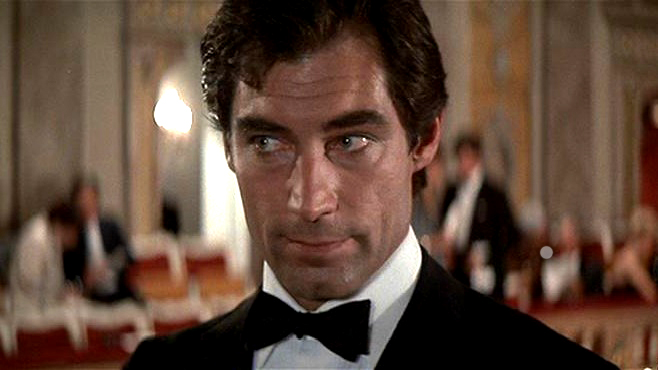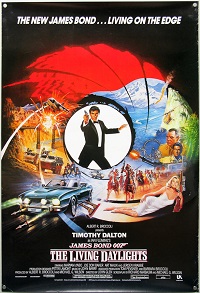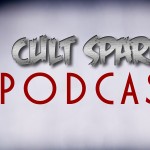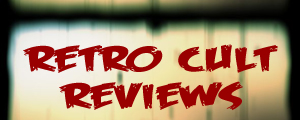
To the casual Bond fan, The Living Daylights is most likely remembered as either "one of those boring Timothy Dalton ones" or maybe "the one where Bond sled-rides on a cello case." The latter is admittedly true; Bond does indeed make a hasty getaway down a snowy mountain atop a cello case. And I must say, it's absolutely delightful. The former, however, is a bunch of hooey. The Living Daylights is anything but boring. Yes, it's true that the Dalton era is mostly an afterthought in Bond lore. Coming after the diminishing returns of the Roger Moore era, Dalton starred in just two largely ignored Bond movies — this one and License to Kill — before Pierce Brosnan swooped in and saved the franchise at the box office.
And while License to Kill is indeed forgettable nonsense, you might be surprised by a The Living Daylights re-visit. The truth is it's a fantastic Bond movie, one that brings a darker edge to Bond after the sillier Moore installments. Dalton got caught playing Bond at a bad time, but he wasn't a bad choice. He's still flirty and cracks jokes as the character, but he also comes across as a truly dangerous man, a trait that only Daniel Craig, of all the Bond actors, pulls off better. There's a scene in this where Bond rips the clothes off an innocent woman, leaving her standing there nude and terrified, just to distract a Russian guard so Bond can get the drop on him. It's brutal and slightly uncomfortable, as spy work must be from time to time. Dalton's Bond is no-nonsense when it comes to the work.
 And The Living Daylights is very much a spy movie. That's one of the things I love about it. A lot of spy movies are just generic action movies with big set pieces where spy work is used as window dressing. But this film fits the more classic model of a spy film. The plot involves the defection of KGB officer Georgi Koskov (professional snake Jeroen Krabbé), who tells MI6 that Russia has re-activated a program targeting foreign spies. This seems backed up by the murder of 004 in the pre-title sequence. However, something doesn't sit right with Bond, who begins uncovering a conspiracy involving a beautiful cellist (Maryam d'Abo), an American arms dealer (Joe Don Baker) and an opium deal between Koskov and some Afghani Mujahideen. Bond spends a lot of time in this movie using traditional spy tactics to suss out just exactly what in the hell is going on. He tails people and observes. He romances the cellist, creating a false back-story to quickly gain her trust and find out where she can lead him. He helps fake the death of a Russian general to trick the bad guys into moving forward with their plan, which doesn't involve trying to destroy half the world or anything. It's just a couple of assholes scheming to get rich, as most real-world villains are.
And The Living Daylights is very much a spy movie. That's one of the things I love about it. A lot of spy movies are just generic action movies with big set pieces where spy work is used as window dressing. But this film fits the more classic model of a spy film. The plot involves the defection of KGB officer Georgi Koskov (professional snake Jeroen Krabbé), who tells MI6 that Russia has re-activated a program targeting foreign spies. This seems backed up by the murder of 004 in the pre-title sequence. However, something doesn't sit right with Bond, who begins uncovering a conspiracy involving a beautiful cellist (Maryam d'Abo), an American arms dealer (Joe Don Baker) and an opium deal between Koskov and some Afghani Mujahideen. Bond spends a lot of time in this movie using traditional spy tactics to suss out just exactly what in the hell is going on. He tails people and observes. He romances the cellist, creating a false back-story to quickly gain her trust and find out where she can lead him. He helps fake the death of a Russian general to trick the bad guys into moving forward with their plan, which doesn't involve trying to destroy half the world or anything. It's just a couple of assholes scheming to get rich, as most real-world villains are.
There's a bit at the beginning I like where Bond is ordered to kill the cellist, who's armed with a sniper rifle and aiming at Koskov, but instead he just disarms her with a well-placed shot. The movie slyly hints that it's because Bond is smitten with her, which is kind of dumb but tracks with the character's reputation. So it's a nice surprise when we discover that Bond spared her not because she's pretty, but because his instincts as a spy were telling him she wasn't the assassin she was being set up to be. Dalton's Bond really is an excellent spy in this movie, using his brain and his savvy to piece together the puzzle laid out in front of him. And by the end of the film, you get the sense that Bond really did make an impact on the world at large, even if he may have accidentally created Al-Qaeda … but, uh, let's not dig too deeply into that.
The Living Daylights does not slack on the action either. Backed with a strong script, John Glen and his team are able to put together some of the best action sequences of Glen's five-film stint as a Bond director. The pre-title sequence is a lot of fun, with Bond chasing down 004's assassin before sliding out the back window of a plummeting truck and parachuting down to a luxury yacht (where a lovely female passenger awaits, of course). There's a car chase over ice where Bond uses the rim of his blown-out tire to cut the ice around one of his pursuers, dropping him into a lake. (Corny? Sure. But also kind of clever!) And the film's final act turns into an all-out war between Russian troops and the Mujahideen, where Bond commandeers a plane with explosions going off all around and then has a fist fight with Necros (Andreas Wisniewski), the film's big henchman, as the two are dangling out of the back of the plane on a giant net.
Meanwhile, d'Abo proves to be one of the series' better Bond girls. She's gorgeous and plucky and, best of all, has an actual character arc that tracks from beginning to end. You could see Bond wanting to spend time with her after the end credits roll. Nice supporting cast here too with Baker (playing a completely different character than he plays in GoldenEye), the ever reliable John Rhys-Davies, and Art Malik as the Mujahideen leader.
It's a shame that Dalton only got one more Bond movie, and a fairly awful one at that, before he stepped away from the franchise in the tumultuous period between License to Kill and GoldenEye. There's no doubt the series thrived under Brosnan's care, and I have no complaints about him in the role. (See: my love for GoldenEye.) But I really think it was just a matter of poor timing with Dalton. The first Lethal Weapon came out the same year as The Living Daylights, as did Beverly Hills Cop II. Die Hard was released one year later, and License to Kill had to compete directly with Lethal Weapon 2 and Tim Burton's Batman. Action films were getting bigger, smarter, funnier and more elaborate, and Bond's old-school charms were unable to compete. The series needed to take some time off, let the public start to miss it, and then come back recharged and renewed. A new lead actor was pretty much necessitated by circumstance.
But Dalton deserves to be more than a Bond afterthought, if only for the stellar work he does in The Living Daylights, which also happens to be one of the series' very best installments. Oh, and also, A-ha's theme song absolutely rules …











